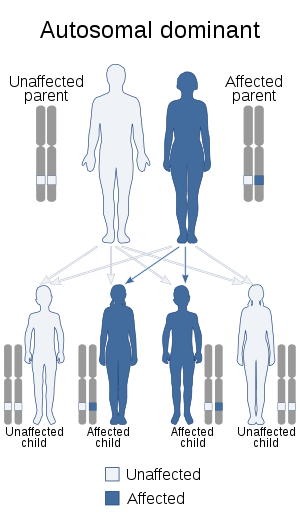PAPA syndrome
PAPA syndrome is an acronym for pyogenic arthritis, pyoderma gangrenosum and acne. It is a rare genetic disorder characterised by its effects on skin and joints.[2][3]
| PAPA syndrome | |
|---|---|
| Other names | Pyogenic arthritis-pyoderma gangrenosum-acne syndrome[1] |
 | |
| PAPA syndrome is inherited in an autosomal dominant pattern. | |
Signs and symptoms
PAPA syndrome usually begins with arthritis at a young age, with the skin changes more prominent from the time of puberty.
The arthritis is the predominant feature, noted by its juvenile onset and destructive course. Individuals often recall episodes of arthritis precipitated by a traumatic event. With repeated episodes the joints become damaged with multiple joint replacements required. Hopefully, with improved treatment options, the damage will be limited in new cases.
Pyoderma gangrenosum is variably expressed, which means that it is not always present in all individuals with the disease. It presents as poorly healing ulcers with undermined edges. Pathergy is an important feature (this term refers to the tendency of ulcers to arise at points of injury). There are reports of lesions developing at the site of a joint replacement wound, central venous line and intravenous drip insertion.
Acne affects most individuals with PAPA syndrome but to a variable degree. It is usually of a severe nodulocystic type which if untreated results in scarring.
Genetics
PAPA syndrome is inherited in an autosomal dominant fashion, which means that if one parent is affected, there is a 100% chance that a child will inherit the disease from a homozygous affected parent and a 50% chance that a child will inherit the disease from an affected heterozygous parent.
Recently the responsible gene has been identified on Chromosome 15.[4][5][6] Two mutations have been found in a protein called CD2 binding protein 1 (CD2BP1).[7] This protein is part of an inflammatory pathway associated with other autoinflammatory diseases such as familial Mediterranean fever, Hyperimmunoglobulinemia D with recurrent fever, Muckle–Wells syndrome, neonatal onset multisystem inflammatory disease, and familial cold urticaria.[8]
Diagnosis
Clinical features along with the familial tendency may be enough to make a diagnosis. Genetic testing may also be used.
Treatment
Acne treatment may require oral tetracycline antibiotics or isotretinoin. Treatments directed at tumor necrosis factor (TNF) (infliximab, etanercept) and interleukin-1 (anakinra) have shown a good response in resistant arthritis and pyoderma gangrenosum.[9][10][11] Other traditional immunosuppressant treatments for arthritis or pyoderma gangrenosum may also be used.
See also
- SAPHO syndrome
- Psoriatic arthritis
- List of cutaneous conditions
References
- RESERVED, INSERM US14-- ALL RIGHTS. "Orphanet: Pyogenic arthritis pyoderma gangrenosum acne syndrome". www.orpha.net. Retrieved 27 April 2019.
- Lindor NM, Arsenault TM, Solomon H, Seidman CE, McEvoy MT. A new autosomal dominant disorder of pyogenic sterile arthritis, pyoderma gangrenosum, and acne: PAPA Syndrome. Mayo Clin Proc 1997; 72:611-5.
- McDermott MF, Aksentijevich I. The Autoinflammatory syndromes. Curr Opin Allergy Clin Immunol 2002; 2(6): 511-516.
- Yeon HB, Lindor HM, Seidman JG, Seidman CE et al.Pyogenic Arthritis, Pyoderma Gangrenosum, and Acne Syndrome Maps to Chromosome 15q. Am J Hum Genet 2000; 66:1443-8.
- Lindor NM, Arsenault TM, Solomon H, Seidman CE, McEvoy MT. A new autosomal dominant disorder of pyogenic sterile arthritis, pyoderma gangrenosum, and acne: PAPA Syndrome. Mayo Clin Proc 1997; 72:611-5.
- Wise CA, Bennett LB, Pascual V, Gillum JD, Bowcock AM. Localization of a gene for familial recurrent arthritis. Arthritis Rheum. 2000 Sep; 43(9):2041-5.
- Wise CA, Gillum JD, Seidman CE, Lindor NM, Veile R, Bashiardes S, Lovett M. Mutations in CD2BP1 disrupt binding to PTP PEST and are responsible for PAPA syndrome, an autoinflammatory disorder. Hum Mol Genet. 2002 Apr 15; 11(8): 961-9
- Shoham NG, Centola M, Mansfield E, Hull KM, Wood G, Wise CA, Kastner DL. Pyrin binds the PSTPIP1/CD2BP1 protein, defining familial Mediterranean fever and PAPA syndrome as disorders in the same pathway. Proc Natl Acad Sci USA. 2003 Nov 11; 100(23): 13501-6.
- Stichweh DS, Punaro M, Pascual V. Dramatic improvement of pyoderma gangrenosum with infliximab in a patient with PAPA Syndrome. 2005 May-Jun; 22(3): 262-5.
- Cortis E, De Benedetti F, Insalaco A, Cioschi S, Muratori F, D’Urbano LE, Ugazio AG. Abnormal production of the tumor necrosis factor alpha and clinical efficacy of the TNF Inhibitor Etanercept in a patient with PAPA syndrome. J Pediatr. 2004 Dec; 145 (6): 851-5. Erratum in: J Pediatr. 2005 Feb; 146(2):193.
- Dierselhuis MP, Frenkel J, Wulffraat NM, Boelens JJ. Anakinra for flares of pyogenic arthritis in PAPA syndrome. Rheumatology (Oxford). 2005 Jan 5;(Epub ahead of print)
External links
| Classification | |
|---|---|
| External resources |